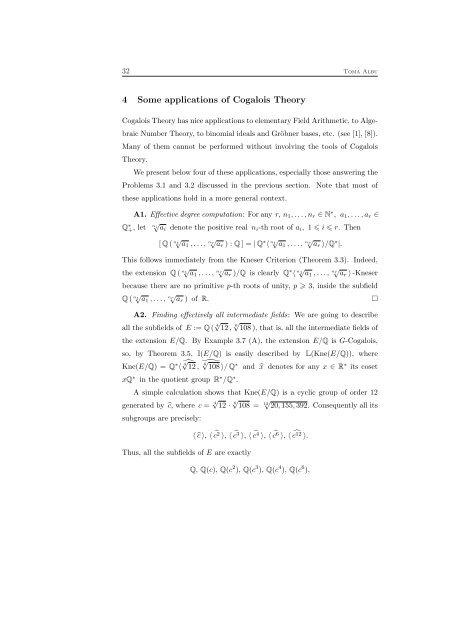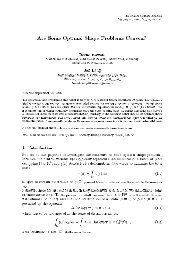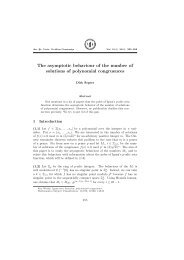the irrationality of sums of radicals via cogalois theory
the irrationality of sums of radicals via cogalois theory
the irrationality of sums of radicals via cogalois theory
- No tags were found...
Create successful ePaper yourself
Turn your PDF publications into a flip-book with our unique Google optimized e-Paper software.
32 Toma Albu4 Some applications <strong>of</strong> Cogalois TheoryCogalois Theory has nice applications to elementary Field Arithmetic, to AlgebraicNumber Theory, to binomial ideals and Gröbner bases, etc. (see [1], [8]).Many <strong>of</strong> <strong>the</strong>m cannot be performed without involving <strong>the</strong> tools <strong>of</strong> CogaloisTheory.We present below four <strong>of</strong> <strong>the</strong>se applications, especially those answering <strong>the</strong>Problems 3.1 and 3.2 discussed in <strong>the</strong> previous section. Note that most <strong>of</strong><strong>the</strong>se applications hold in a more general context.A1. Effective degree computation: For any r, n 1 , . . . , n r ∈ N ∗ , a 1 , . . . , a r ∈Q ∗ √n+, let i ai denote <strong>the</strong> positive real n i -th root <strong>of</strong> a i , 1 i r. Then[ Q ( √ n 1a 1 , . . . , nr√ a r ) : Q ] = | Q ∗ 〈 √ n 1a 1 , . . . , nr√ a r 〉/Q ∗ |.This follows immediately from <strong>the</strong> Kneser Criterion (Theorem 3.3). Indeed,<strong>the</strong> extension Q ( √ n 1a 1 , . . . , nr√ a r )/Q is clearly Q ∗ 〈 √ n 1a 1 , . . . , nr√ a r 〉 -Kneserbecause <strong>the</strong>re are no primitive p-th roots <strong>of</strong> unity, p 3, inside <strong>the</strong> subfieldQ ( √ n 1a 1 , . . . , √ n ra r ) <strong>of</strong> R.□A2. Finding effectively all intermediate fields: We are going to describeall <strong>the</strong> subfields <strong>of</strong> E := Q ( 4√ 12 , 6√ 108 ), that is, all <strong>the</strong> intermediate fields <strong>of</strong><strong>the</strong> extension E/Q. By Example 3.7 (A), <strong>the</strong> extension E/Q is G-Cogalois,so, by Theorem 3.5, I(E/Q) is easily described by L(Kne(E/Q)), whereKne(E/Q) = Q ∗ 〈 ̂4√ 12 , ̂6√ 108 〉/ Q ∗ and ̂x denotes for any x ∈ R ∗ its cosetxQ ∗ in <strong>the</strong> quotient group R ∗ /Q ∗ .A simple calculation shows that Kne(E/Q) is a cyclic group <strong>of</strong> order 12generated by ĉ, where c = 4√ 12 · 6√ 108 = 12√ 20, 155, 392. Consequently all itssubgroups are precisely:〈 ĉ 〉, 〈 ĉ2 〉, 〈 ĉ3 〉, 〈 ĉ4 〉, 〈 ĉ6 〉, 〈 ĉ12 〉.Thus, all <strong>the</strong> subfields <strong>of</strong> E are exactlyQ, Q(c), Q(c 2 ), Q(c 3 ), Q(c 4 ), Q(c 6 ),






